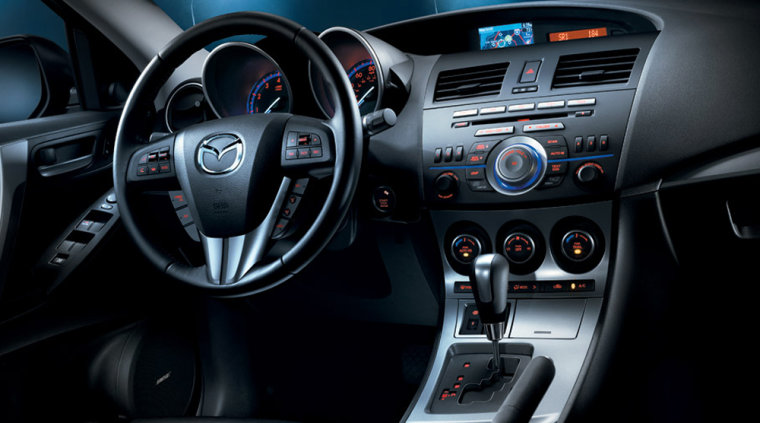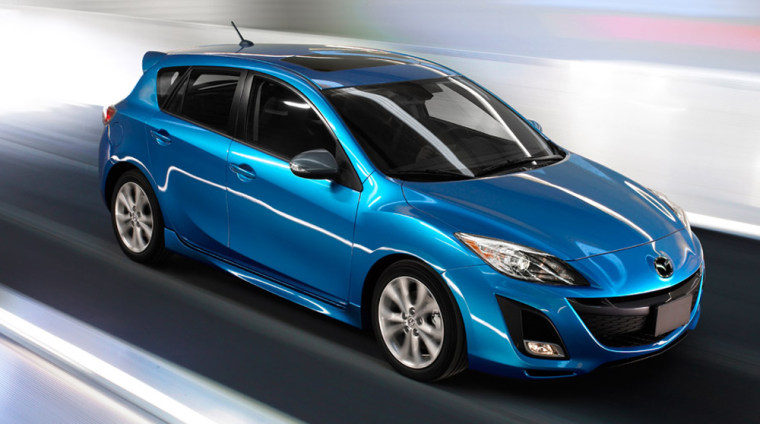During this season of graduations it may be that Mazda is marking an achievement of its own: promotion out of the morass of mass-market brands and into the realm of aspirational brands.
No, Mazda isn’t poised to challenge Mercedes or Cadillac for valet prestige at Spago. But with new models like the Mazda3, the company is clawing its way upward into the territory occupied by brands such as Saab, Volvo, Acura and, until its own recent promotion into the big leagues, Audi.
The Mazda3 is available as either a taut five-door hatchback or as traditional four-door sedan. The sedan outsells the hatch by about 2:1, but the mini-wagon hatch is probably the image leader with younger buyers. It would be interesting to see what the market’s reaction would be to a sportier three-door version with a sloping hatchback.
The new model’s styling is only mildly revised from its popular predecessor, the car which showed Mazda meant business in its assault on perennial small car market leaders Toyota Corolla and Honda Civic.
Nice as the old car was, it wore an icebreaker’s bluff prow, so the new car’s “wedgier” leading edge is filed down, contributing to a drag coefficient that has been shaved to 0.29 for the sedan and 0.31 for the hatchback.
However, the changes bring a new drawback, and that is the car’s execution of Mazda’s new signature corporate grille style, which unfortunately apes the grotesque grin of Batman’s adversarial clown. On the Mazda3, at least, the bumper is low enough that having a distortedly silly grille aperture below it keeps the miscue mostly out of sight. The company’s crossover SUVs, however, weren’t so lucky and now appear to have been defaced by the Joker’s henchmen. Or are they his minions? Hard to be sure.
Identifiable styling and a deserved reputation for sporty driving dynamics have boosted Mazda3 sales by 9 percent over last year, as cash register receipts are beginning to reflect the car’s appeal. Canadians have been faster to catch on to the Mazda3’s combination of affordability, efficiency, excitement and refinement, as they have made the car the best-selling model in that country, according to Mazda. That’s not the best-selling car in its segment, it is the best-selling car overall in the market, and in some months its sales have topped even the mighty Ford F-150 for title of best-selling vehicle.

The Mazda3’s cabin enjoys more soft surfaces than most of its competitors in the small car segment and it can be outfitted with many of the features typically associated with upmarket models such as heated leather seats (with 8-way power adjustments on the driver’s side), dual-zone climate control, power moonroof, push-button keyless start, a navigation system and a 10-speaker Bose sound system.
Unlike past half-hearted efforts, Mazda did more than just include these features, it made the extra effort to see that they work properly. The seat heaters now use a five-position thumbwheel to set the heat level and the heating elements are usefully distributed through the seat bottom and lower back area. Previous Mazda seat heaters, in contrast, were simple on-off affairs with skimpy heating coils that failed to include the thighs and lower back, so it is nice to see improved attention to the details that make the difference between a spec sheet check-off item and an actual useful accessory.
Less successfully executed is Mazda’s take on accessory controls. BMW introduced the despicable iDrive central controller system to combat the plague of buttons in cars, and while that cure proved worse than the disease, the Mazda reminds us that a profusion of buttons whose operation is not obvious is still a problem worthy of solution.
Recognizing that in this price segment most owners would consider an aftermarket GPS device rather than a costly, large-screen factory navigation system, Mazda built in a more affordable small screen GPS device. Full credit to Mazda for thinking outside the cliché, but the steering wheel-mounted buttons for this device only add to the excess of controls. This might be acceptable if the stereo controls weren’t so obtuse. Fortunately none of this interferes with the Mazda3’s delightful driving dynamics.
Both the front and back rows offer plenty of space for two adults. Three in the back would get a little snug for grown-ups, and the rear door openings are set so far back it can be a challenge to get feet into and out of the car. The voluminous cargo hatch area reminds us of the benefit of the mini-wagon roofline with its resulting tall cargo space.
The company offers similarly lavish exterior accoutrements; not just high-intensity discharge headlights, but active high- and low-beam lights that steer as much as 15 degrees into corners to shine light around upcoming bends. There are also rain-sensing wipers, heated outside mirrors and turn signal repeaters for lane changes.
Under the hood, Mazda offers either a 2.0-liter or 2.5-liter four-cylinder engine, and either a six-speed manual or five-speed automatic transmission. The manual is obviously the enthusiast’s choice, and Mazda’s is a good one, with short, accurate shifts and a light clutch pedal.
The more popular automatic transmission is well programmed so drivers won’t find themselves constantly at odds with their car’s decision making about gear selection. The automatic also includes the pointless opportunity to move the shifter into a manual gate and change up or down by hand, but drivers who want to shift manually tend to want the real thing and not an impersonation of a manual trans. Better to just leave it in “D” and drive.
It all works impressively on the road, which is no accident. The old Mazda3 was already appreciated for its handling prowess, so rather than figuring it was “good enough” or that customers wouldn’t mind if they trimmed a little cost out of the car at the expense of handling, Mazda upgraded it further. Made the front end stiffer by using “structural adhesive” as well as welding in its construction.
Yeah, that’s pretty much just epoxy from Napa (the auto parts store, not the wine-producing region of California), but it is well proven to enhance rigidity even if it enjoys all the glamour of duct tape.
And the engineers mounted the steering rack more firmly, for improved steering feel. They also bucked the trend of switching to electric power steering for its cost and fuel economy benefits. Instead, the power steering is the usually much better hydraulic variety, but its pump is spun as-needed by an electric motor rather than an accessory belt on the engine.
That means the car enjoys both the fuel savings of electric steering and the dynamic benefits of hydraulic steering. Naturally, this best-of-both approach exacts a price in terms of cost and complexity, but for the “zoom-zoom” company to preserve and even extend its credibility, these are the kinds of decisions that are necessary.
Such decisions also look good on the Mazda3’s transcript as graduates from the “cheap car” segment into the premium car arena, where some of its would-be competitors may be resting on reputations cultivated when the market was less competitive and upstarts like Mazda knew their place. Unfortunately for them, it seems the Mazda3’s place is among the premium small cars.
